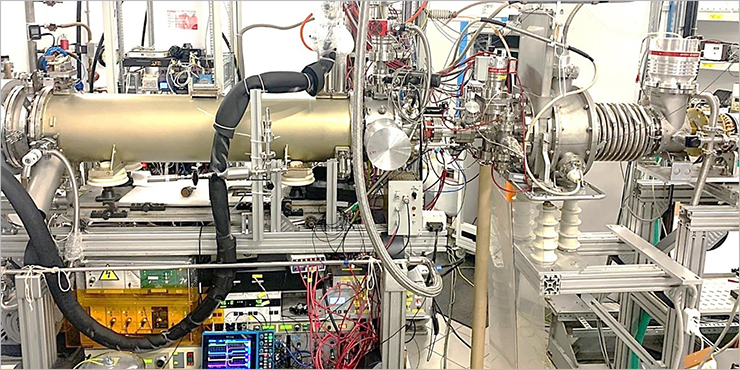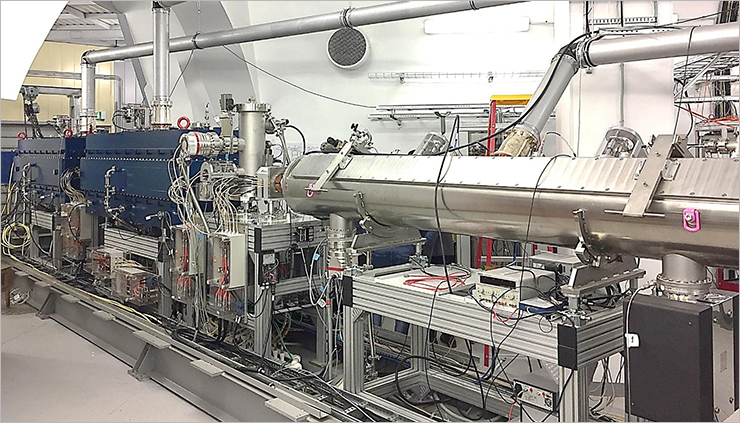How does injector of NICA Complex work?
News, 17 May 2023
The injector of NICA at VBLHEP JINR is a part of the accelerator complex, where a charged particle beam is formed, accelerated, and transported before getting into the Booster and Nuclotron Cyclic Accelerators. As part of a series of popular science lectures at the JINR Scientists’ Club, senior engineer of the Laboratory of High Energy Physics Dmitry Ponkin spoke about the creation of the technical part of the complex and its special electronics and how scientists produce beams of charged particles for experiments.
 VBLHEP senior engineer Dmitry Ponkin
VBLHEP senior engineer Dmitry Ponkin
He said that the NICA Injection Complex includes two injectors, the heavy ion injector, as well as the light ion and polarised proton one. The injectors, in turn, consist of sources of charged particles (ions, protons, and deuterons), linear accelerators, and transport channels to the Nuclotron and Booster Cyclic Accelerators.
The light ion injector has existed since the launch of the Synchrophasotron. It has been upgraded several times, and until recently was based on the LU-20 Linear Accelerator. The light ion injector is being updated as part of the construction of the NICA Complex. In addition, specialists will replace LU-20 with a new linear accelerator, which is being created jointly with the German company BEVATECH.
The heavy ion injector was created and put into operation in 2016 in cooperation with the same BEVATECH and the Helmholtz Centre for Heavy Ion Research (GSI). The new linear accelerators operate on the principle of homogeneous radio-frequency quadrupole focusing. It was first proposed in the USSR by scientists Ilya Kapchinsky and Vladimir Teplyakov at the Institute for Theoretical and Experimental Physics (ITEP).
 KRION-6T (left) and the beginning of the heavy ion linear accelerator (right)
KRION-6T (left) and the beginning of the heavy ion linear accelerator (right)
The process of producing a beam at the heavy ion injector takes place in the KRION-6T Ion Source, a pulsed cryogenic superconducting ioniser of heavy element atoms. It allows obtaining beams of highly charged heavy element ions. After leaving the ion source, the beam passes through the low-energy beam transfer (LEBT) and gets into the heavy ion linear accelerator (HILAC), where it is accelerated to an energy of about 5 MeV/nucleon. After HILAC, the beam goes through another transport channel and enters the Booster Cyclic Accelerator.
The KRION-6T Ion Source is an experimental development of the direction of electron-beam ion sources, the idea of which was first proposed by Professor Evgeny Donets at LHE JINR in the 1970s. Atoms of the working fluid, usually gas, in electron-beam ion sources are kept inside the drift structure by an ion trap. Then they are ionised by electrons for the required time, and extracted from the source by a positive voltage pulse.
“The accelerator complex operates in a pulsed mode. We inject bunches, then they are accelerated in the Booster and Nuclotron Cyclic Accelerators. After a few seconds, they are slowly, up to 5 seconds, extracted at the target,” the engineer explained.
Production of the ion beam in the source, diagnostics, estimation of its size, intensity, and position in the transport channels, as well as control of the magnetic correction elements and many other aspects are provided by special electronics developed by a team of engineers from the VBLHEP Accelerator Department.
Dmitry Ponkin also noted that VBLHEP is doing a lot of work to develop and manufacture the electronics necessary for both the injector and other parts of the accelerator complex. For example, VBLHEP develops beam diagnostics systems, synchronisation complexes, high-voltage electronics, flexible plates for cryogenic sensors, and much more. Dmitry said that many of the solutions concerning electronics for NICA are corporate. The team of the VBLHEP Accelerator Department is doing a lot of work to replace some of the project solutions with their own.
“Once we have an idea for a particular electronic module, adopt the model, and start its implementation, we develop a functional diagram, on the basis of which a printed plate layout can be designed,” he said.
For example, the model of the signal synchronisation system at the NICA Complex, developed at VBLHEP, was implemented in 2017 in the form of a crate with optical inputs, an optical receiver, and a pulse synchronisation signal splitter.
The next stage is design simulation, which is also called 3D-modeling. This is a computer simulation of three-dimensional objects, the purpose of which is to ensure the correct manufacture and further assembly of the technical system. At this stage, the assembly of individual elements is simulated, plates are attached, etc. The development of printed plates is carried out not only for devices, digital and control modules, but also for various sensors. “In the production and manufacturing of printed plates, we work closely with our colleagues from Zelenograd, as well as from FLNP and DLNP,” Dmitry noted. “It takes a lot of time to write clear terms of reference. As we dive into the task, we try to improve, modernise, or simplify some aspects of the work. Those people who are able to understand the course of the task, the physics of the process, make calculations, obtain circuit solutions, model and implement them in the form of plates, modules, systems, are called full-stack developers”.
Many ideas and developments for the injection complex have been implemented at the NICA Cyclic Accelerators and channels for applied research. “There are a number of requirements for the equipment at the accelerator complex. First, there should be a systematic approach, i.e. everything should be made within the general idea. In addition, reliability, the possibility of expansion and remote control are important, too,” Dmitry Ponkin added.
Currently, specialists continue to optimise the operation of technical systems at the KRION Heavy Ion Source and the HILAC. They refine and fix the deficiencies identified after the 2023 run.




